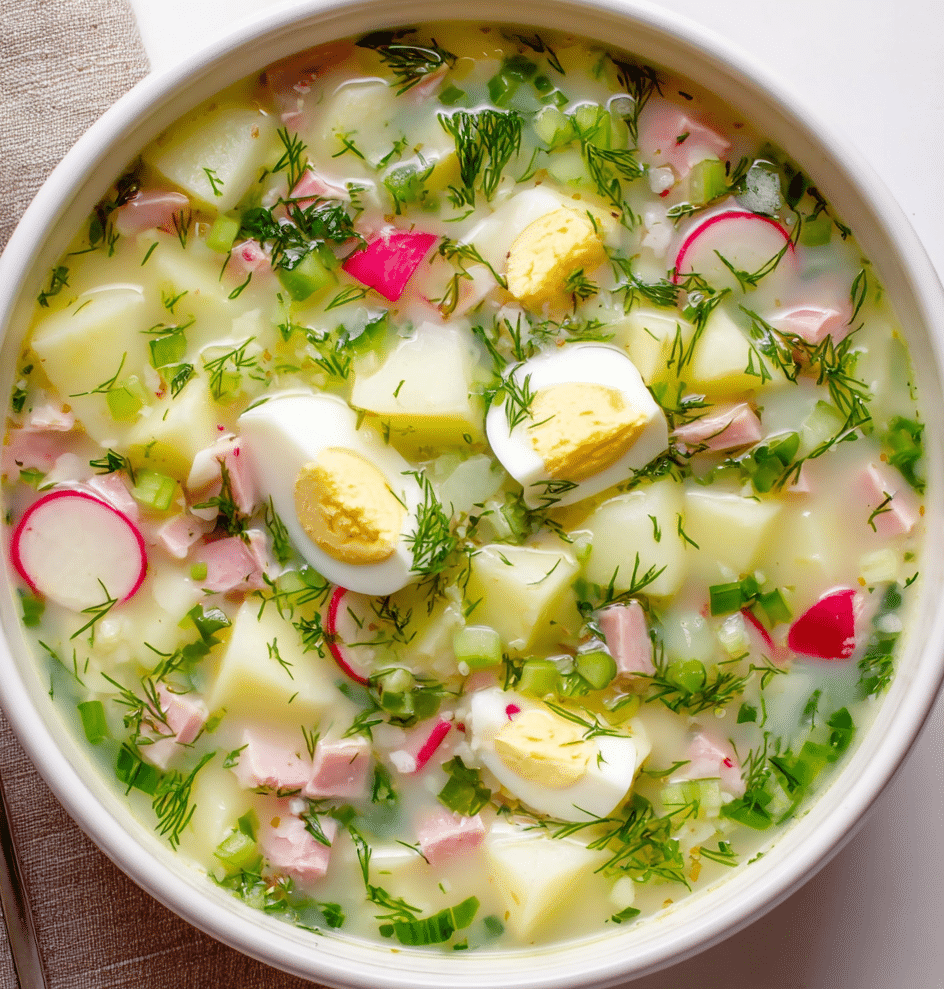The beauty of Okroshka lies in its lightness, balance of flavors, and cooling effect — a true summer delight from the heart of Russian cuisine. Made with kefir, crisp cucumbers, boiled potatoes, eggs, and aromatic herbs, it’s a harmonious blend that’s both nourishing and refreshing.
Perfect for scorching days, Okroshka skips the stove (except for a few boiled ingredients) and rewards you with a chilled bowl of probiotic goodness. Whether you go the traditional route with ham or keep it vegetarian, this soup is endlessly adaptable, bright, and full of garden-fresh flavor.
Full Recipe
Ingredients:
-
2 medium potatoes, boiled and diced
-
4 hard-boiled eggs, chopped
-
3-4 radishes, sliced thin
-
1 small cucumber, diced
-
2 green onions, chopped
-
1/4 cup fresh dill, chopped
-
1/4 cup fresh parsley, chopped
-
7 oz (200g) cooked ham or boiled beef, diced (optional)
-
3 cups kefir (or plain yogurt thinned with water)
-
1 cup cold water (adjust to consistency)
-
1 tablespoon lemon juice or vinegar (optional, to taste)
-
Salt and pepper, to taste
Directions:
-
Boil potatoes until tender, peel and dice. Set aside to cool completely.
-
Hard boil the eggs, peel and chop finely.
-
Dice cucumber, radishes, and meat (if using). Chop green onions, dill, and parsley.
-
In a large bowl, combine all chopped vegetables, eggs, herbs, and meat.
-
Pour kefir and cold water over the mixture. Stir to combine.
-
Season with salt, pepper, and lemon juice or vinegar if desired. Adjust consistency by adding more cold water.
-
Chill in the refrigerator for at least 1 hour before serving.
-
Serve cold, optionally garnished with a sprig of dill or a boiled egg half.
Prep Time: 20 minutes | Cooking Time: 20 minutes | Total Time: 40 minutes
Kcal: 180 kcal | Servings: 4 servings
What is Okroshka?
Okroshka is a traditional cold soup that originates from Russia and other Eastern European countries. It is particularly popular during the warmer months because of its refreshing, tangy, and light nature. Unlike hot soups that comfort us in winter, Okroshka is a vibrant medley of raw vegetables, boiled potatoes and eggs, herbs, and optionally, meat — all combined with a base of kefir, kvass, or diluted sour cream. It’s the Eastern European answer to the summer heat, balancing crisp textures and cool flavors in one deeply satisfying bowl.
The name “Okroshka” is derived from the Russian word “kroshit’,” which means “to crumble” or “to chop into small pieces.” This is a fitting name, as the dish is essentially a finely chopped salad submerged in a creamy or fermented liquid. This cold soup isn’t just food — it’s a reflection of Eastern European heritage, health-conscious eating, and seasonal cooking at its best.
A Historical Glimpse into Okroshka
The earliest versions of Okroshka trace back to peasant food traditions, where preservation, fermentation, and simplicity were key to survival. Farmers and villagers would often make use of whatever was available from their gardens, mixing cold boiled vegetables with fermented bread drinks like kvass to create a hydrating and nourishing meal.
Originally, kvass — a lightly fermented rye-based drink — was used as the liquid base, giving the soup a slight tang and effervescence. Over time, regional variations developed. In modern households, kefir, a cultured dairy product similar to buttermilk or yogurt, has become more common for its creamy texture and probiotic qualities.
Okroshka became especially popular during the Soviet era, as it was cheap, easy to prepare, and adaptable based on what ingredients were on hand. Today, it remains a symbol of nostalgic family traditions while being embraced by modern cooks looking for lighter, healthier options.
Why Okroshka is Perfect for Summer
Summer in Russia and Eastern Europe can be surprisingly hot, and Okroshka is considered the ideal antidote to the heat. Its base — whether kvass or kefir — is always served ice-cold. The dish is often kept in the fridge and served straight from it, making it a go-to meal when it’s too warm to turn on the stove.
The combination of cold liquids and raw, hydrating vegetables like cucumber and radish refreshes the palate, cools the body, and prevents dehydration. The soup is light yet satisfying due to the addition of protein from eggs and meat, and complex carbs from potatoes. It’s a complete meal in a bowl, with textures ranging from crunchy to creamy.
Okroshka is also incredibly quick to assemble if you prepare the components in advance. Many home cooks boil the potatoes and eggs the night before, then combine everything just before serving for maximum freshness and crunch.
Nutritional Benefits of Okroshka
Okroshka isn’t just delicious and refreshing — it’s also packed with nutritional value. The soup is naturally high in fiber, vitamins, and minerals thanks to the variety of vegetables used. Cucumbers and radishes bring hydration and antioxidants; boiled potatoes provide energy and potassium; while fresh herbs like dill and parsley are rich in vitamin C, vitamin A, and folate.
When made with kefir, Okroshka offers a powerful dose of probiotics, which help support gut health, improve digestion, and boost the immune system. Kefir also supplies protein and calcium, while being easier to digest than milk, making it suitable even for some people who are lactose intolerant.
For those watching their calorie intake, Okroshka is an excellent low-calorie, nutrient-dense option. Omitting the meat or using lean proteins like turkey or chicken breast can make it even lighter. It’s also naturally gluten-free, and vegetarians can enjoy it without the meat. With simple ingredient swaps, it can even be made vegan by using plant-based yogurt or kefir.
Kvass vs. Kefir: The Base Debate
One of the most debated aspects of Okroshka is what base to use. Traditionalists swear by kvass, a fermented drink made from rye bread. Kvass has a slightly sweet and tangy taste with a fizzy quality, which makes the soup light and bubbly. It’s an acquired taste for some, but it adds a unique old-world character to the dish.
Kefir, on the other hand, has surged in popularity because of its creamy consistency and health benefits. It brings a slight tartness and a velvety finish to the soup, which many modern eaters prefer. You can also thin yogurt with a bit of water or use buttermilk as an alternative.
Each base gives the soup a distinct identity. Some families even make hybrid versions, mixing kvass with kefir to achieve both tang and creaminess. The beauty of Okroshka is that it’s endlessly customizable — there’s no “one true way” to prepare it.
Regional Variations Across Eastern Europe
Though commonly associated with Russian cuisine, Okroshka and its variants are found throughout Eastern Europe, each region adding its own twist.
In Ukraine, the soup may include sour cream or even mineral water to achieve the desired consistency. In Belarus and Latvia, beetroot is sometimes added for a splash of color and earthy sweetness. Polish cold soups like “chłodnik” are similar in spirit but often use beets as the primary base.
Some households use smoked meats or even seafood for a gourmet upgrade. Others keep it strictly vegetarian with an extra helping of fresh herbs. In Jewish cuisine, variations may use schmaltz (rendered chicken fat) or omit dairy entirely.
These adaptations show that Okroshka is more than just a recipe — it’s a canvas for cultural and personal expression.
Tips for the Best Okroshka Experience
-
Chill everything: For a truly refreshing experience, all ingredients — especially the kefir or kvass — should be cold. Some even add ice cubes just before serving.
-
Cut uniformly: To ensure even flavor and texture, dice all ingredients into similar bite-sized pieces.
-
Season last: Always season with salt, pepper, and lemon juice or vinegar at the end. Taste and adjust, as the flavor can change once everything is mixed.
-
Let it sit: Allowing the soup to rest in the fridge for an hour or so before serving lets the flavors meld beautifully.
-
Add fizz: For a playful twist, try mixing a splash of sparkling water with the base liquid. It enhances the soup’s refreshing qualities.
Conclusion: Why Okroshka Deserves a Place at Your Table
In a world where food often leans toward the over-complicated, Okroshka stands out as a beautiful example of simplicity done right. It brings together the best of seasonal eating, healthful ingredients, and cultural history in a bowl that’s as versatile as it is delicious. Whether you’re exploring global cuisines, seeking a gut-friendly dish, or just trying to beat the heat, Okroshka is a perfect choice.
More than just a cold soup, it’s a celebration of freshness and family tradition — one that invites customization and creativity. Its unique combination of textures and temperatures creates a dining experience unlike any other.
Okroshka may be rooted in Eastern European kitchens, but its universal appeal makes it a global gem. Add it to your summer recipe collection, and you’ll discover just how satisfying a cold soup can be — light, nourishing, and surprisingly addictive.






